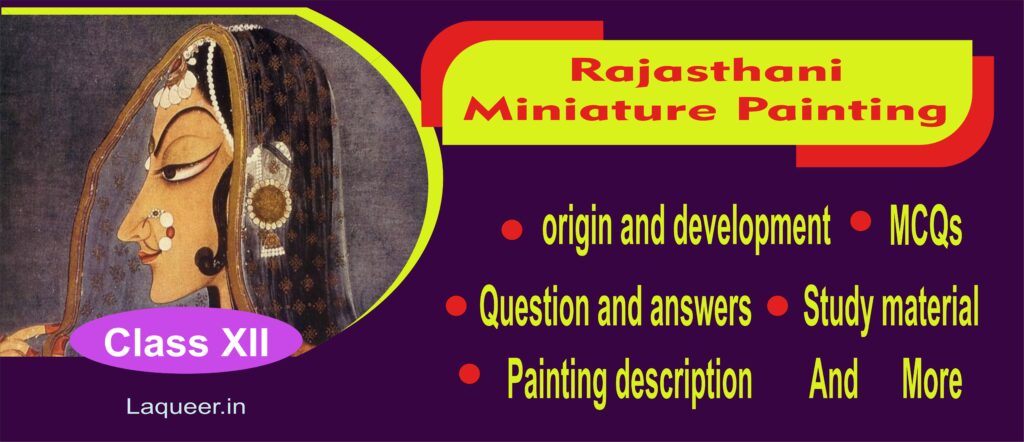
Rajasthani School of Miniature Painting
A Journey Through Time and Colours
Introduction
The realm of Indian art is a treasure trove of diverse styles, each originating from a distinct region and reflecting its rich cultural heritage. Among these is the Rajasthani School of Miniature Painting, an exquisite art form that has flourished for centuries in the desert state of Rajasthan, India. This unique and awe-inspiring tradition is a harmonious blend of color, technique, and storytelling, capturing the essence of Rajasthan’s history, myths, and daily life. In this blog, we embark on a captivating journey into the origin, development, and prominent features of Rajasthani miniature painting.
I. Origin and Historical Background
The Rajasthani School of Miniature Painting finds its roots in the early 16th century during the reign of Rajput kings and Mughal emperors. It emerged as a response to the Persian miniature style, with local artists infusing their distinct Rajasthani elements into the artwork. The vibrant courts of Rajasthan, including those of Mewar, Marwar, and Amber, became nurturing grounds for this art form. The paintings were initially commissioned to depict court scenes, royal portraits, religious themes, and literary epics.
Rajasthani school of miniature painting flourished between 16th to early 19th century in the principalities of Rajasthan. Dr. A coomarswami The great scholar of Indian Art History discovered this school and introduced it as Rajput school.
Later this school was called Rajasthani school. Rajasthan is divided in to parts by the aravali parvat,on the west are the jodhpur ,Bikaner and Jaisalmer to the east Mewar ,Bubdi ,kishangarh and kota .first of all the painting started from Mewar to Bundi and other parts of state.
It was inspired and influenced by Jain manuscripts painting of Gujrat along with Indian traditional art. Krishna leela is the most popular theme in the Rajasthani school. these topic have been derived from the literary work of Surdas .Tulsidas ,Meera bai Keshav das and Bihari lal also from Bhagvat Puran ,Ramayna and Geet Govinda etc.
Earlier this style was inspired by Vaishnava religion at that time the followers of Ramanuj like Ballabhachaarya Chaitany Mahaprabhu etc. Had reached this religion to the climax. Important illustrations of Ramayana and Mahabharat of this school are also founded.
Besides this theme later on painting have been done on romance ,general folk themes .illustration on Ragmala ,Barhmasa and Nayk -Nayika Bheda,etc. Mewar ,Bubdi jodhpur , Bikaner ,Kishangharh and Jaipur are the sub-school of Rajasthani school of Miniature painting .
II. Evolution and Development
1. Sub-schools:
Over the centuries, the Rajasthani School of Miniature Painting evolved into several sub-schools, each with its unique style and characteristics. The prominent sub-schools include the Mewar, Marwar, Bundi, Kota, Kishangarh, and Jaipur schools. These sub-schools flourished under different patronage, and each brought its innovative techniques and artistic expressions.
2. Influence of Nature:
Rajasthani miniature paintings are deeply influenced by the region’s natural beauty, such as the Thar Desert, colorful flora, and diverse wildlife. The paintings often feature landscapes, sceneries, and depictions of seasons, adding a touch of serenity and mysticism.
3. Rich Color Palette:
One of the most striking features of Rajasthani miniature paintings is their brilliant and vibrant color palette. The artists used natural pigments derived from minerals, plants, and even semi-precious stones, creating intense and long-lasting hues. Saffron, indigo, vermilion, and gold were commonly used, giving the paintings a regal charm.
III. Main Themes and Paintings
1. Ragamala Paintings:
Ragamala paintings are a unique genre within Rajasthani miniatures, which combine visual art with classical Indian music. Each painting depicts a particular musical mode (Raga), accompanied by verses describing the mood and essence of the melody. These paintings are an enchanting fusion of music, poetry, and painting, evoking a plethora of emotions in the viewer.
2. Bani Thani:
Bani Thani, also known as the Indian Mona Lisa, is a famous painting from the Kishangarh sub-school. It portrays a slender, elegantly attired woman with exaggerated features, symbolizing divine beauty. The artwork beautifully captures the essence of femininity and has become an iconic representation of Rajasthani art.
3. Krishna Leela:
Another prominent theme in Rajasthani miniatures is the portrayal of Krishna’s various playful antics. Scenes from his life, such as stealing butter (Makhan Chor), playing the flute (Murali Manohar), and his divine love with Radha, are popular subjects that showcase the artists’ skill in depicting emotions and intricate detailing.
Conclusion
The Rajasthani School of Miniature Painting is not merely an art form; it is a window into the vibrant history and culture of Rajasthan. These breathtaking masterpieces exemplify the artistic prowess of the region’s talented artisans and serve as a timeless testament to their creativity and imagination. As we immerse ourselves in the enchanting world of Rajasthani miniature paintings, we find ourselves transported to an era of splendour and grace, where colours, stories, and traditions come alive on a canvas no larger than a palm.